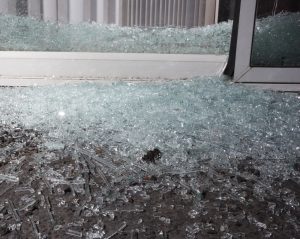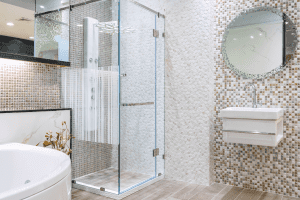Storm doors have grown immensely popular due to their low cost and ease of use. They, like everything else, need regular maintenance due to their frequent usage. Because of the friction caused, they tend to become difficult to close, and lubricating them might help open and close it smoothly. We've researched this topic thoroughly to provide you with facts on properly lubricating your storm door.
A few drops of penetrating oil on hinges and door closers will help protect the worn surface between the pin and the housing. The crucial part is to repair the storm door closer by adjusting the hinges to start the lubrication.
If you want to learn more on how to lubricate a storm door closer in detail, please continue reading. In this post, we'll teach you how to fix a squeaky storm door closer appropriately. We'll also discuss how to lubricate a storm door hinge and some resources you can use.

How Can a Storm Door Closer Be Repaired?
It's likely that your storm door closure merely needs tension adjusted. Find the tension adjustment screw on the door closer. Turn the screw clockwise to tighten and slow the door closing. Turn the screw counterclockwise to loosen and speed up the door closing.
How Do You Adjust the Tension on Your Door Closer?
Adjust the door closer by turning the adjustment screw clockwise or counterclockwise, you'll need a step ladder to reach the closer. Then descend the ladder, and observe the result. Watch the door close at least six to ten times to verify the tension is how you'd prefer.
The two most often adjusted sections of a door are hinges and closers. You should tighten hinge screws during lubrication. The screw eventually turns as the wood door frames dry out and the screw holes open. If hinge screws can no longer be tightened, you'll need to fill the gap with hardening filler, redrill it, and reinstall the screw.
Is It Necessary To Have Two Closers on a Storm Door?
Your storm door probably has two closers. Setting the speed on these may assist to avoid slamming and ensure a tight close. Adjust one of two closers at a time.
How Do You Fix a Squeaky Storm Door Closer?
The reason for a noisy door affects the remedy. If you can't figure it just by looking at the door, try one of these five repairs. If the first doesn't work, try the next. If you succeed, you'll learn why your door squeaks and how to avoid it in the future.
1. Clean the hinges
Storm doors collect dirt due to their exposure, especially around the hinges. It's hard to determine how much dirt is on the hinge pin unless you remove it. Remove the hinge pin and check it. If there is dirt or dust, carefully clean and lubricate it.
If the hinge pin is rusty, use rust remover or steel wool to clean it. Replacing it in the hinge and putting the door through its paces.
2. Lubricate the hinge
Firstly, lubricate the hinge. Any multipurpose oil from your local hardware store will do. Apply two drops on the hinges and shake the door to disseminate the oil. It should rapidly remove the squeak.
You may need to remove each hinge and oil individually before replacing them and retesting the door.
3. Drill and tighten the screws
If the door hangs freely and doesn't line correctly with the jamb, tighten the screws. To accomplish this, use a screwdriver. The squeak should be gone.
Keep an eye on the hinges in case it happens again. The use of storm doors regularly may create alignment issues.
4. Loosen screws
The screws may be coiled excessively tightly if your door is new, causing a loud opening and closing. The installer should be able to fix this immediately.
If they don't, you may try loosening the screws manually. Slowly close the door, so it doesn't slip off the hinge. Too much loosening might produce the same issue, so find a happy medium. If it still squeaks, contact the installer to ensure the door was correctly sized and positioned.
5. Inspect the hinge or pin
If everything else fails, the hinge or pin may be faulty. A cursory look at the hinges should tell if the barrel gaps are even. Remove the pin with a screwdriver and check each hinge individually. Check for consistency. If the hole is small, use a hammer and the pin to carefully re-align the hinge.
How Do You Lubricate a Storm Door Hinge?
Silicone spray and plumber's grease are the most acceptable lubricants for hinges. In terms of sloppiness and longevity, silicone spray is the best.
Click here for B'Laster Silicone Lubricant on Amazon.
In contrast to 3-in-1 oil, the plumber's grease is lightweight and solid enough not to run off the hinge. It lasts longer than silicone spray but is more difficult to apply. Use automotive grease if you have some on hand.
Click here for Plumber's Grease on Amazon.
How to Apply Silicone to One Hinge at a Time?
1. Identify the squeaking hinge first, then you may remove the pin when the door is closed and fastened. Confirm your side of the door has everything you need. With a screwdriver or a pry bar, you can access beneath most detachable pin hinges.
2. Put the silicone spray tube on the nozzle, direct the spray towards the hinge, and slowly squeeze the nozzle until the silicone spray softly drizzles out. In case of overspray or leaking paint, place a paper towel beneath the hinge. Spray just enough to dampen the hinge's connecting parts.
3. Loosely insert the pin into the hinge and spray it with extra silicone to lubricate it.
4. Tap the pin in to engage the hinge and respray it.
5. Ensure the hinge is firmly in place. A bit of additional silicone spray on the hinge seams will help stop the squeaking. After that, clean the hinges of any silicone.
Lubricating the Hinge Pin With Grease
Apply a tiny layer of grease down the pin's length, then a small glob on the business end to distribute the grease. Tap the pin in. Then work the oil into the hinge by opening and shutting the door entirely. A little lubricant in the joint where the hinge sides meet might help squeaks.
Can You Use Olive Oil To Fix a Squeaky Storm Door?
Olive oil fixes squeaky hinges.
Using olive oil to lubricate squeaky hinges is simple. Use a pipette or an oil can to make the procedure as simple as possible. Apply a few drops of olive oil to the hinges, and they will stop squeaking.
Is WD-40 Bad for Door Hinges?
Many people say WD-40 works well as a door lubricant. Whether you want to lubricate your door hinges or anything else, WD-40 may be utilized efficiently. WD-40 multipurpose spray may be used for numerous applications other than lubricating doors.
The WD-40 spray can easily remove oil and filth from your door hinges. Apply the WD-40 spray on the door hinges and let it sit for a few minutes. After a while, clean the door hinges with a clean towel. Remove the oil simply and avoid letting the substance drop down your door.
Click here for WD-40 on Amazon.
Final Thoughts
Squeaky storm doors are inconvenient, and they're also an indication that your door isn't in good repair. The problem, which might be a loose screw, lubrication concerns, improper alignment, or broken hinges, will determine the treatment.
One of the options given above may address each of your concerns. Others, like removing the hinge pin and hammering it back into shape, are more challenging.
The repairs will simply take a few minutes or hours if the issue is complex. But bear in mind that frequent door maintenance will prevent your doors from squeaking. Proper lubrication, cleaning hinges, using a door closer, and checking for loose screws will reduce squeaky storm doors.
Do you have more storm door questions? Check out our related posts:






